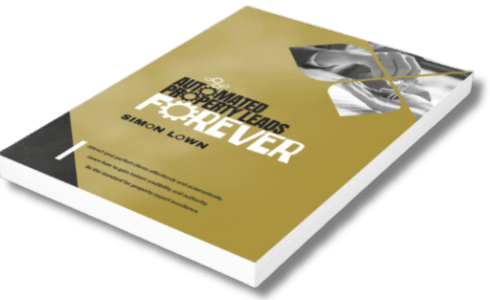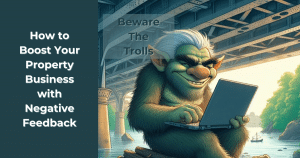One of the biggest mistakes that property professionals make, especially estate agents, is not creating a diverse range of content. In this post, we’ll take a look at the 5 content types you need in your property content goldmine. While the types of content that make up a goldmine will be influenced by a few factors, a single type of post, day in, day out, will never be the right way to go.
You know what I’m talking about. When you go to the agent’s Facebook page, who, for some reason, caught your attention, and all you find is a list of properties for sale or rent and precious little else.
SEEN IT. NEXT.
Yeah! That’s not exactly going to inspire anyone to like or comment on the post, let alone share it.
Why Your Property Lead Generation Needs a Content Goldmine!
If you want a successful property business, you need to be able to talk to people about where they are in their journey. The problem for most property experts is that they never get to speak to a prospect at the right time.
Getting in front of your perfect prospect at the ideal time will rarely happen if you only wait to speak with people. You have to have a way of showing up when people are looking for solutions to problems. That’s where your content goldmine becomes invaluable.
Your knowledge, recorded on video, formatted as a blog, and converted into checklists, cheat sheets, case studies and testimonials, will all build into a valuable resource that can be indexed and searched by Google and ready for when your perfect prospect goes looking for answers. This is the core of your content goldmine, but it will extend into your socials, emails, and every other marketing channel you utilise.

A Few Quick Stats
You might know that I love a good stat, so let’s look at some benefits of creating a vibrant content ecosystem for your business.
It would be my sincere hope that many of these stats will be familiar to you. Many more Key Performance Indicators (KPIs) can be tracked. These are all drivers of the most important KPI: your profitability.
- Engagement Rates: A study by HubSpot found that companies with a diversified content strategy saw an average engagement increase of 20%.
- Lead Conversion: A Demand Gen Report found that businesses that employ a multi-channel approach in the property sector experience a 15% higher rate of lead conversion.
- Customer Retention: A study by Invespcro found that 70% of property businesses report better customer retention rates when they diversify their content offerings.
- ROI: The Content Marketing Institute found that diverse content strategies in the property sector show an ROI improvement of 10%.
- Time Spent on Site: Neil Patel found that sites offering a mix of video, text, and interactive content see an average time-on-site increase of 5 minutes. This is a biggie. You’ll learn more in my SEO post.
- Email Open Rates: Campaign Monitor found that email newsletters with a mix of property insights, market trends, and personal stories experience an open rate of 25%.
- Social Media Interaction: Buffer found that property businesses utilising a mix of blog posts, videos, and social media posts see a 10% increase in overall social media interactions.
- Cost Per Lead: A study by Outgrow found that multi-channel content marketing lowers the average cost per lead by 10%.
- Booking Rates: Lead Forensics found that companies that diversify their content experience 15% more bookings than those that don’t.
- Client Testimonials: G2 Crowd found that 80% of clients are likelier to leave a positive review for property companies that engage them through varied content.
Any one of these stats on its own might not seem like it’s worth the effort of building a content goldmine. Add them all together, though, and WHOA! That’s a different story.
Is there a way to quantify this into an actual cash amount? No, not easily. But let’s give it a go.
An Example
Let’s say you’re a UK estate agent with a turnover of £250,000 per year, and you net 40%.
If we applied some cash figures to those stats based on our fictional average company turnover and profits, we might expect to see an increase of £20,000 yearly.
So, at first glance, our content goldmine does indeed generate an increase in revenue, but once we factor in the time taken and possibly some outsourcing costs, we aren’t exactly rolling in cash.
Stats Don’t Tell The Whole Story
What these figures don’t take into account, though, is the following:
- Not every company generates income from all of these KPIs in the first place
- More regularly published content will create a compounding effect
- The impact on brand awareness and trust isn’t factored in here
- The cost of existing advertising will reduce as targeting effectiveness increases
- Leads generated organically via Google cause lead prices to go down
- As lead quality goes up, conversion rates go up
- As your content and SEO gets better, more people will find your content
- Your credibility as the go-to expert skyrockets
- If a piece of content goes viral (not guaranteed), your other content benefits massively
When you start to consider all these other factors, it’s hard to imagine the impact it will have after two, three, or five years of consistently being a content leader in your space.
Despite all this, it is understandable that most property experts don’t create a wide variety of content using multiple media types across many platforms.
It’s hard to come up with fresh ideas regularly, and turning them into content takes time.
That is, unless you have a content goldmine.
When you have a plan to convert all of your expertise, knowledge, experience, stories, values, and passion into vast digital versions of, well, you, then coming up with a diverse range of high-quality and varied content becomes childs play.
The Content Landscape: Where Many Go Wrong

The main reason you can’t rely on a single content strategy anymore is choice.
Your future clients have so many ways to interact with people, companies, and brands that they are spoilt. They can choose whichever method they like and still get exactly what they want.
This means that the more places you can show up with a variety of content, the more chance you have of catching the interest of your perfect prospects. And, more importantly, keeping their attention.
Here are a few examples of standard practices in the property world that no longer work on their own:
- A real estate agency that only publishes blog posts about new listings. This might attract some initial interest, but it’s unlikely to keep people engaged or convert them into leads.
- A property management company that only uses social media to promote its services. This might reach a wider audience, but it’s not as effective at building relationships or generating leads as other channels, such as email marketing or webinars.
- A mortgage lender that only creates white papers and case studies. This type of content can be helpful for informing and educating prospects, but it’s not as engaging as other formats, such as videos or infographics.
If you don’t, or worse, can’t diversify your content strategy, you will struggle to remain relevant and attractive to your perfect prospects.
While you don’t have to start using every content strategy at once, you do want to think about how you can begin to diversify.
The Significance of Variety: Spice Up Your Content Game
Now you know that sticking to a single type of content that generates limited interest is likely one of the main reasons you’re not getting as many leads as you’d like.
Are there any other reasons that you should up your content game?
Well, simply, Yes.
If you don’t have variety in your content, you’ll miss out on potentially attracting many of your perfect prospects.
There are all types of people looking for different things during the various stages of their journey. For some, it will be information and education about overcoming a problem or particular situation they find themselves in.
Others might be looking for emotional support or an agent they resonate with and can trust to help them achieve their desired outcome.
Some will just be looking for engagement because they are in the early stages of a possible future plan. They may not be looking for somebody to sell them on any particular course of action, but they are still “in the market” for knowledge and like the personal touch.
Maybe you have a prospect who is ready to go ahead, but they can’t quite decide who they should go with, and a little bit of persuasion is all they need to be your next candidate for a five-star review.
Having a variety of content is the only way you’ll get in front of your perfect prospects with a message that will resonate and engage them at their journey stage.
The Marvels of Blogging: Your Trusty Sidekick in Lead Generation
Many think creating a blog is just about writing a load of text, and you’re done.
When a blog is done well, it is much more than that.
Depending on the length of your content, you can employ many tools, tips, and tricks to keep your content exciting and engaging.
The first thing to note is that when a topic justifies it, you always want to write in-depth content over a short-form format.

Here is a list of reasons why:
- Long-form content is seen as more valuable
- It more easily positions you as an expert
- It helps establish your authority
- You can tell stories to engage your audience and take your audience on a journey
- You have more room to include images, infographics and videos, keeping interest high
- Long content is more likely to be shared
- Long content is more likely to rank highly on Google
If all that isn’t enough, when somebody spends 15, 20, or 30 minutes engaging with your content, it increases the likelihood they will want more. They will learn who you are, what you stand for, and why you’re there to help them. The chances of you building trust, resonating with your audience and having them get a massive takeaway from your insights are increased exponentially when you take the time to thoroughly explain their problem and outline the solution in a way they can comprehend.
If you only have a load of 3 to 5-minute pieces of content, what can anyone really learn about you, your brand, or your services? Do you really think you can establish your authority in 5 minutes?
I wish you all the best with that strategy.
Quick Tips For Writing Engaging, Insightful Blogs That Resonate With Your Target Market
One of the great things about creating a blog is that you already have loads of content ready to go on the tip of your tongue.
If you know how to help somebody 1 to 1, you can write a post about the same topic.
While it may take a bit more thought and planning, you’ve already got the answers.
Literally.
This is where you start your content goldmine. Answering the most commonly asked questions.
If you write down every question you get asked regularly, you know you have a topic many people want to know the answer to.
Now, if that question has an answer that “depends”, then you have a way to make an exciting post.
All you need to do is this:
Take your main question, and at every point where your answer will change depending on a variable or situational component, list as many of the variables as possible.
Once you have your answer map, jump onto Google or your favourite AI and see if you have missed any.
Now, you can start writing your post to answer the questions that everyone asks you while incorporating the various situations people might need to consider when dealing with this problem.
When you add in your stories, experiences, and values, you’ll end up with a unique piece of content that many people will be looking to find to solve their own related issues.
Subtopics to Cover in Your Blogs
Depending on the type of question you are answering, you’ll have the opportunity, in many instances, to enhance your content with some of the following:

- Market trends
- Property management tips
- Local community highlights
- Success stories/testimonials
- Other related viral content
Another benefit of having a content goldmine is that as it grows, you’ll be able to reference what might be considered an in-depth topic without needing to explain it in detail. You can just touch on the salient points, add a reference to the full post, and continue explaining the subject at hand.
Video Content: The Crown Jewel of Engagement
Of course, no blog post will be complete without an embedded video.
The ins and outs of video is such a vast topic that I can’t go into too much detail here, so I’ll only briefly touch on the benefits of video here.
- Video has very high engagement rates
- Video is excellent for SEO
- It enhances your credibility
- Listening to a video can make things easier to understand
- Video is better at conveying emotional content and context
- Video increases the likelihood of getting shared
When you create enough video content, and you’ve made lots of the standard talking head style videos for your blog, you’ll also improve your property tours, client testimonials, “day-in-the-life” videos, etc.
Many people will use all kinds of filler words, ums, ahs, and various other forms of non-descript language. The more you practice, the better you will get. Eventually, you’ll reach a point where you know exactly what you need to say and how you’ll say it, and your retakes and edits will fall to a very low level. It takes a little time, but you’ll get there.
If you don’t currently make regular video content for your business, you’ll be amazed at the difference it makes once you start.
Social Media: The Interactive Billboard
Hopefully, I don’t need to go into the power of social media here. I think we can all agree that social media works. The main problem is that most people forget 50% of the equation.
To be clear, it’s SOCIAL media.
It doesn’t work nearly as well without the social part.
As I mentioned at the top of this post, this is where most estate agents, but not just them exclusively, get it wrong. Social media should not be treated as another property portal or a place where you only advertise your latest and greatest offer.
The key to effective social media is delivering value. This is where your content goldmine comes into its own. If you’ve written an 8000-word post about how to get on the property ladder, there will be dozens of opportunities for you to take video snippets or quotes from your post and repurpose them to attract people looking to solve that problem.
Creating new engaging headlines and testing new images will be very easy compared to the effort it took to write your content masterpiece.
Social Media Variety: Up the Interest
Even though delivering value is a crucial part of your social strategy, you’ll still want to be exciting and varied in your approach to delivering said value.
That means you can’t just switch from using your socials as a property portal or an advertising billboard to a series of promotions for your latest blog and video posts.
You’re going to need to be a little more creative than that.
Try using a few of these post types as well:
- Engagement posts
- News or trending posts
- Competitions
- Memes
- Video Shorts (snippets)
- Memes
- Questions
- Polls
- Quotes
- Behind-the-scenes posts
There are many variations of social posts you can use, so don’t get stuck on using just one or two.
Social Media Calendar: Your Blueprint for Success
Each platform has its own ‘best practices’ for posting. You’ll need to test and research what is best for each social channel for your audience.
There are, however, a few universal truths to posting:
- Consistently posting is recommended
- Posting content that doesn’t get engagement reduces your organic reach
- Planning content in advance saves time
- Time-saving by using social media management tools reduces reach
- Finding the best time to post helps increase your reach
- Relevant hashtags increase the longevity of your content (Findable in future)
- Having a consistent brand enables you to build an engaged audience
- Experimenting is good for helping you stand out
I’m not going to try and pretend that I’m a social media guru or that there is a single strategy you can find that will catapult you into social stardom. This is a list that I have picked up through various courses, posts, and influencer chats and that fits in with my understanding of technology and beliefs about how the world works.
Buyer Beware
Many courses, programmes, coaches and agencies will tell you they have figured out social media, paid ads, and organic reach. If they’re not billionaires, I would take their claims with a pinch of salt.
Nobody knows what the algorithms are for any social platform. If you follow John Mueller of Google fame, you might even get the sense, as I do, that even the companies that own the algorithm don’t fully understand their own.

Nearly every agency, freelancer, and coach in existence got to where they are by testing. They get results by testing. They help others by testing. Even multimillion-pound agencies that run ads for the most prominent clients run multiple tests before launching large campaigns. Even then, they don’t always get it right.
Don’t be fooled by the hype. Even an expensive agency that says it will guarantee results will still need time and ad budget for testing. While they may have a system to get results quicker, they still won’t know what works for your business until they do some testing.
If there is a strategy that is guaranteed above all others to work, it’s consistently showing up with valuable content and testing what your audience reacts to.
Email Newsletters: The Classic That Still Packs a Punch!
Email marketing is still effective and can become even more so when used with your content goldmine. Referencing your catalogue of content throughout your mailing campaigns not only delivers more value to your clients but could also give your content an indirect SEO boost.
We know that ‘time on page’ is an important metric for Google Analytics, and if there is engagement on a post, it signals to Google that people like what they see. So, if your email list is big enough and enough of your audience clicks through, it’s happy days all around.
Direct Line to Customers
Emails, of course, go directly into a person’s inbox. This is unlike social media algorithms that decide what content users see.
When you align your email content with the reason that somebody signed up to your list in the first place, usually because they got one of your content upgrades (a lead magnet) from your content goldmine, you are aligned with their needs. You provide more value and build trust, rapport and brand awareness without a hint of selling.
High Engagement
Many people still check their emails regularly, with many having email on their smartphones and having notifications enabled.
While the engagement might not quite match the likes of Facebook Messenger, it is still very effective.
Affordable & Cost-Effective
An email list is still a very low-cost option for direct marketing compared to other methods, and it has excellent ROI.
Personalisation Power
One of the great benefits of mass marketing using email is the personal touch. Nobody likes to feel like they’re just a number in a machine that’s going through the motions of contacting hundreds or thousands of others. Personalisation gets around this and works very well.
Measured Success
Pretty much every autoresponder and mailing list manager in existence today can track various metrics. If you have low-ticket products for sale, you can even directly follow the ROI for every email sent.
The best metric you can track, though, in my humble opinion, is the open rates. Testing different headlines and seeing which gets the most opens will tell you much about what people are looking for. Most platforms can A/B test headlines, so ensure you use it often and track the results.
Crafting Emails That Are Impossible to Ignore
Like any headline, your emails must be attention-grabbing and get your audience to want to click. If you’ve got my book, you’ll already know about my guide, The Perfect Hook™, which will help you generate catchy headlines using one of the many formulas available.
If you don’t have your copy of my book yet, you can find The Perfect Hook™ 👈here for free.
No sign up required.
It has 48 formulas with examples for you to try, as well as a couple of bonuses for maximising the effectiveness of your headlines.
Here are a few other techniques that you can use to try and increase your open rates:
Pique Curiosity
Do you have a contrarian view? How about an opinion that is unpopular with other property professionals? If you’re willing to be bold and back up your claims, then you should absolutely test them.
Urgency and Scarcity
This could be a compelling motivator, depending on where the urgency is coming from. If, for example, new regulations or taxes are coming into effect, you should use your platforms to inform and educate your audience about the potential cost of a delay.
If, on the other hand, you just want to shift a few extra units of products, you might want to save that for your Instagram page.
Personalisation
We’ve already discussed this, but you can also personalise your email’s headings. Don’t underestimate the power of seeing your own name used as part of a headline.
Content That Captivates
While everything from the headline to your Call to Action is important, the opening few lines of your message are the only opportunity to captivate and engage your reader.
You could lose them quickly if you don’t grab their attention and draw them into your content.
The first line must captivate the reader, much like the subject line, and every sentence following should build on your message.
Relevancy is Key
Unlike a post for your content goldmine, with an email, brevity is your friend. Being concise and to the point is what will keep your readers engaged.
If somebody opens an email and sees it’s a miniature version of War and Peace, there’s a good chance they’ll “save it for later”, also read as – they’ll never get around to reading it.
Visual Elements
There are two schools of thought regarding the most effective email style. One is that it should be formatted for mobile and be text only. Hyperlinks are acceptable at the top, middle, and bottom, and you can make the text larger so it’s easier to read.
Then there is the branding argument, which says brand everything. Break up text with GIFs, short videos or images. Make it look visually appealing while ensuring the message is optimised for mobile and desktop.
As someone who sees a hundred or more emails weekly, I can tell you I don’t give it much thought. Who it’s from and what’s in the headline are the factors that determine if I’ll open a message. That said, I may not be a typical subscriber, so test everything.
You can test to see what works best with your audience. You can even ask your subscribers which they prefer and have two versions of every email. It’s a little more work, but it will probably be worth it if it increases open rates and engagement.
Brevity with Impact
While brevity is your friend for keeping your email list engaged, it’s a rule that can be broken on occasion if there is reasonable cause.
Whether you’re keeping your messages short and brief or occasionally going for a longer format, the one thing that cannot change is that your message delivers value.
Never send out a message without a purpose. Education and information are all good, but ensure they align with your audience’s wants and needs.
If you send out too much fluff and content that does not enrich your prospects, people will stop opening your messages.
Call-to-Action (CTA) That Converts

You can use CTA’s almost anywhere. In your content goldmine, on your social channels, in your email messages or any other medium you care to name.
It’s important to note that you should only have one CTA in a message. Multiple CTAs will confuse people as to what you expect them to do.
If people are confused about what to do, they will most likely do nothing.
Be Direct
CTA’s that convert aren’t long or wordy. Be clear and concise about what you expect your audience to do. Up to this point, you should have already clarified the benefits of your message. Now, all you have to do is highlight the main points again.
Strategic Placement
You can have your CTA anywhere in your message. The reason they opened the message will often help you decide the best location.
If, for example, you send a special offer message, then the CTA should be above the fold and instantly clickable.
A bonus for reading an educational piece of content will most likely be placed at the end of the message.
A limited-time offer might be placed 3 or 4 times throughout the message to emphasise the urgency of the CTA.
Design Matters
It is well known amongst marketers that the size, colour, style, shape, and font of a CTA can all impact the click-through rate.
As with all of your marketing, test everything.
Crafting Newsletters That People Will Actually Open
Just like your perfect prospects will be attracted to different pieces of content you created depending on their current situation, they will likely react in different ways to your newsletter.
Segmentation and personalisation
You already know that personalisation works well and is something you should be utilising. However, you can take a step further by segmenting your list.
Creating a newsletter tailored to each individual would take a considerable amount of work, so I’m not suggesting you try. However, if you can create groups of people with similar interests, it’s relatively simple to set up mail branches that are only delivered to people with specific interests using email tags.
Frequency and timing
How often you deliver your newsletter will also impact the open rates. If people get a weekly newsletter and don’t find the content really valuable, they’ll stop opening it quite quickly.
On many autoresponder platforms, there is an option you can use that sends out a newsletter at the same time somebody subscribes. This can be helpful since it might be a time that your subscriber is on their computer or phone and will have spare time to consume your content.
You want to make it as convenient for your subscribers to read your content as possible.
The art of the follow-up
This is where knowing your prospects’ avatars really pays off. You can get their attention by following up with personalised information that you know they are interested in.
If you know why they sign up for your newsletter / lead magnet / any other information that involves them giving you their email address, and you understand the journey they are likely to be on, then you can really impress them with the value you can deliver.
Client Testimonials and Case Studies: The Proof Is in the Pudding!
This is another area where I feel most property professionals get it wrong. Even if you are one of the few experts who understand the importance of a 5-star review and ask your clients for it, you can do so much more.
The importance of social proof in the property industry
While your content goldmine is going to do a lot of heavy lifting when it comes to positioning you as the go-to expert, there’s nothing like the words of a satisfied client to demonstrate why others should consider using your service.
If I look at a website and only see three or four “testimonials” from “past clients” with no video, no links to a recognised review site, or even a full name…
Yeah! I’m guessing you have your “doubts” too.
How to effectively gather and showcase testimonials and case studies
First, you should be surveying every client for feedback on your services before you ask for a review, let alone a testimonial.
There should never be a situation where you get a 1* review “out of the blue”. If somebody is unhappy with your service, you should at least have a clue long before the review stage.
A Step-By-Step Guide to Soliciting Glowing Reviews & Testimonials
First, it goes without saying that your service needs to be the best it can be. If you know that you can do a better job but don’t, you’re probably in the wrong business, and a content goldmine will do the opposite of what you might expect.
You can move on to the first step once you have delivered your best level of service.
Requesting a review
The first step is to ask for feedback. This is best done near the end of delivering your service. It can also include a request for feedback via a survey. It’s easy to set up an automated questionnaire asking for specific information about the level of service a client has received.
Once you have a completed review, you need to check it for ways to improve your service to other clients in future.

Assuming all is well, thank your client for the valuable information they have provided. You can now ask for a review after some time has passed, maybe a week. You might suggest it as a small favour to let others like them know about the — use a quote from their feedback about a specific area of your service – and send a link to a trusted review service.
Making it easy for the client
You want to make it as easy as possible for your clients to help you tell others about your service.
This might mean asking for specific feedback on certain aspects of your service that you know will help others. It might be reminding them of comments they have made that would show you in a good way.
Whatever you can do will increase the chances of getting those 4 and 5* reviews.
Promoting positive reviews
When you get your latest 5* review, don’t forget to promote them on your social platforms and your website. Replacing older reviews on your website with up-to-date ones will keep them relevant to people finding you for the first time.
Testimonials and Case Studies
Testimonials tend to be better than a review, but only if it is on video. You can ask most of your clients if they would be willing to provide a video testimonial to showcase them on your website. You might be surprised at how many say yes.
Case studies are even better than a testimonial. Still, I would suggest limiting your requests to clients that required a level of service above and beyond what might typically be expected.
There are a couple of reasons for this.
A case study will be a more personal account of the client’s journey and must be planned out in much more detail. You can create a case study in several ways, but again, video will be a lot more effective. If you can do a Q&A style video where you cover the main points, you’ll be able to demonstrate your rapport with the client while showing off your expertise in how you helped them through their journey.
It also takes a lot more time to craft a good case study. Once you have edited, branded, and transcribed the video and created a lead magnet for the services employed to help the client, you’ll have a valuable asset that will promote you, your brand and your expert service for years to come.
Final Thoughts: A Cohesive Content Strategy is Your Golden Ticket
When done well, your content goldmine will become your primary lead source and save you a fortune in advertising and sleepless nights not knowing if you’re getting your message right.
With all the various types of content we’ve discussed, it will be almost impossible for you to be the best-kept secret in your town. You’ll be the best-known, most trusted agent in your area.
However, this will only happen when you know what your content goldmine will look like once it’s complete. That means planning out your content in detail and being committed to promoting it consistently for months, maybe several months before you start seeing the organic fruits of your labour from the likes of Google.
You Will Get There
You will dominate your area when you follow the best practices for creating your content goldmine, using social media, and following up with your perfect prospects until they are ready to go ahead.
But, it will not happen overnight.
It takes time for Google to trust you as a source of expert content.
It takes time to build a social following that engages with your content.
It takes time to build a content goldmine.
If you’re okay with that, all the benefits of owning a content goldmine will be yours.
Just so we’re clear, that is:
- Being known as a trusted property expert
- Being seen as a thought leader in your space
- Getting leads on autopilot, yes, clients too
- Building trust and rapport with prospects when they’re ready
- Providing your service to perfect prospects without selling
If all that isn’t enough, don’t forget that your brand awareness will be everpresent, omnipresent, and trusted by anyone who has asked any property-related question in your area.
Ready to Dig for Gold?
So, you’ve decided that a Content Goldmine is suitable for you, your brand, and your expert property services. How do you make one?
Well, you could get into my Property Leads Accelerator coaching programme. Or, if you’d prefer to find out everything required to build a content goldmine by yourself, you could grab a copy of my book, Automated Property Leads Forever.
It is essentially my coaching programme as a book. Nothing is left out. It’s everything you need to know.
I hope you have found this post helpful. Please leave a comment below, like this post, and share it with your friends.
Enjoy the rest of your day.












